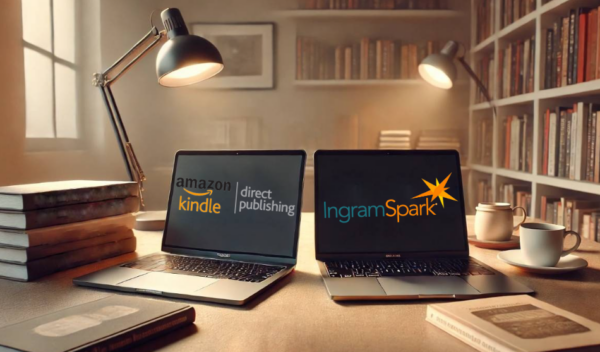In today’s crowded book market, creating a masterpiece is only half the battle; getting it into readers’ hands is the real game-changer. Think of your book as a needle in the literary haystack – effective book distribution is the magnet that pulls it out and places it where readers are looking. With over 3.2 million books published worldwide each year, according to Bowker’s reports, standing out requires more than luck; it demands a solid strategy.
Enter book distribution services. These services—encompassing everything from sales and marketing to customer support—are the unsung heroes that extend your book’s reach far beyond your local bookstore. This article unpacks the key distribution routes for self-published authors, from major online giants to indie bookstore placements and global eBook platforms. With the right approach, your book can travel across the globe, finding its way to readers eager to connect with your story.
Book Distribution
Book distribution is the process of getting your book from the publisher to the reader. It encompasses a range of activities, including printing, warehousing, order fulfillment, and delivery to various sales channels such as online retailers, brick-and-mortar bookstores, and libraries. Book distributors play a crucial role in this process by providing access to digital content and a variety of services for authors and publishers. They simplify the distribution process across different regions and markets, connecting self-published authors with numerous retailers and platforms. Effective distribution ensures that your book is available in the right places where your target audience is most likely to purchase or discover it.
The importance of book distribution cannot be overstated. Effective distribution can significantly impact your book’s sales and readership. A well-distributed book reaches a wider audience, increases visibility, and maximizes sales potential. It also enhances the credibility of the author and the book, making it more appealing to readers and reviewers alike. Without a robust distribution strategy, even the most compelling books can go unnoticed, lost in the vast sea of published works.
Your Publishing Journey Awaits – Start NowMajor Online Retailers
In the digital age, major online retailers have become pivotal in the book distribution landscape. Key players such as Amazon, Barnes & Noble, and Books-A-Million dominate this space, offering extensive platforms for authors to reach a global audience. Amazon, with its Kindle Direct Publishing (KDP) service, is the largest online retailer, providing both print and digital distribution. Barnes & Noble, renowned for its physical stores, also has a significant online presence, particularly with its Nook e-reader. Books-A-Million, while smaller, offers a niche market for various genres and a dedicated customer base.
Benefits of Using Major Online Retailers
The primary advantage of using major online retailers is their unparalleled reach. These platforms attract millions of visitors daily, providing authors with a vast potential audience. The ease of access for readers is another significant benefit; customers can purchase and download books instantly, enhancing convenience and satisfaction. Additionally, these platforms often feature recommendation algorithms that help match books with interested readers, potentially increasing sales.
Major online retailers also offer marketing and promotional tools. Amazon, for example, provides options like Kindle Countdown Deals and Kindle Unlimited, which can boost visibility and sales. The ability to gather and analyze sales data is another perk, allowing authors to understand their market better and tailor their strategies accordingly.
Challenges with Major Online Retailers
Despite the numerous benefits, there are notable challenges when working with major online retailers. One of the primary challenges is the intense competition. With thousands of new books published daily, standing out can be daunting. Authors must invest time and resources into marketing to ensure their books do not get lost in the vast catalog.
Lower profit margins are another concern. Major retailers often set pricing rules and discounts that can significantly reduce the profit per sale. While the volume of sales might compensate for lower margins, it’s a factor that authors need to consider, especially when pricing their books competitively.
Order fulfillment complexities can also pose challenges. While retailers like Amazon handle logistics and shipping, ensuring that the books are consistently available can be tricky. For print books, maintaining inventory levels to meet demand without overstocking requires careful planning. For digital books, issues such as file formatting and compatibility can affect the reader’s experience.
Moreover, the reliance on these platforms means authors are subject to their policies and changes. Algorithm updates, policy changes, or even account suspensions can impact sales and distribution. Authors must stay informed and adaptable to navigate these shifts effectively.
In conclusion, major online retailers offer you a golden opportunity to reach a vast audience and boost your sales. While competition and fulfillment challenges exist, strategic planning and effort can help you overcome these hurdles. By leveraging the strengths of these platforms, you can maximize your book’s potential and shine in the digital marketplace.
Global Ebook Distribution
With the rise of technology, came the rise of eBooks, let’s look at how that affects global book distribution.
The Rise of Ebooks
Ebooks have revolutionized the publishing industry, offering unprecedented accessibility and convenience for readers and authors alike. The growing popularity of ebooks is fueled by the proliferation of digital devices such as smartphones, tablets, and e-readers, allowing readers to carry vast libraries in their pockets. The ease of instant downloads and the ability to adjust font sizes and background colors cater to diverse reader preferences, making ebooks an increasingly attractive option.
Platforms for Ebook Distribution
Several major platforms dominate the global ebook distribution market, each offering unique advantages:
- Kindle Direct Publishing (KDP): Amazon’s KDP is the largest and most popular platform, providing extensive reach through Amazon’s global marketplace. It supports both Kindle and print formats, offering various promotional tools like Kindle Unlimited and Kindle Countdown Deals.
- Apple Books: Apple’s platform leverages the vast ecosystem of iOS devices, making it a significant player in the ebook market. It offers a seamless purchasing experience for users within the Apple ecosystem.
- Kobo: Known for its user-friendly e-readers, Kobo also has a robust ebook store. It has a strong presence in international markets, particularly in Canada, Europe, and Asia, providing a valuable distribution channel for reaching global readers.
- Google Play Books: Google’s ebook platform integrates with the broader Google ecosystem, offering access to a vast audience through Android devices and the Google Play Store.
Strategies for Effective Ebook Distribution
To maximize the potential of global ebook distribution, authors should implement the following strategies:
- Metadata Optimization: Ensuring that your ebook’s metadata—title, author name, description, keywords, and categories—is accurate and optimized for search engines is crucial. Well-optimized metadata enhances discoverability and helps your book rank higher in search results.
- Pricing Strategies: Competitive pricing is essential in the ebook market. Researching similar titles and pricing your ebook appropriately can attract more buyers. Consider experimenting with price promotions and discounts to boost sales and visibility.
- Utilizing Promotional Tools: Leveraging the promotional tools offered by distribution platforms can significantly increase your ebook’s exposure. For example, Amazon’s KDP Select program offers options like Kindle Unlimited and promotional pricing. Regular promotions, free book days, and limited-time discounts can drive sales and attract new readers.
By harnessing the power of global ebook distribution platforms and employing effective strategies, authors you reach a wider audience, increase sales, and establish a strong presence in the digital marketplace.
What is Print on Demand (POD)?
Print on Demand (POD) is a revolutionary model in the publishing world that allows books to be printed as orders are placed, rather than in bulk. This means that a book isn’t printed until someone actually buys it, which dramatically reduces the need for large print runs and storage costs. Print on demand publishing is particularly beneficial for self-published authors and small publishers, enabling them to manage their budgets more effectively while still offering their titles in print. Platforms like Amazon KDP and IngramSpark utilize print-on-demand technology to print and ship books directly to customers without the need for physical inventory, allowing authors to maximize their reach and profits while minimizing upfront costs.
Advantages of POD
The advantages of Print on Demand are compelling. First and foremost, it offers significantly lower upfront costs compared to traditional printing methods. Since you only print books when there’s demand, you avoid the hefty expenses of large-scale printing. Additionally, POD minimizes the risk of unsold inventory. No more worrying about stacks of unsold books gathering dust in a warehouse – with POD, you produce only what you sell.
Flexibility is another key benefit. POD allows you to make quick updates or changes to your book without the financial burden of reprinting large quantities. This adaptability is crucial in today’s fast-paced market, where trends and reader preferences can shift rapidly.
Key POD Services
Several major POD services have emerged as leaders in the industry, each offering unique features to help authors succeed:
- IngramSpark: Known for its wide distribution network, IngramSpark gives authors access to global retail and library markets. It offers high-quality printing and various formatting options to suit different needs.
- Amazon’s KDP Print: Integrated with Kindle Direct Publishing, KDP Print provides seamless distribution through Amazon, the world’s largest online retailer. Its user-friendly platform makes it easy for authors to get their books into print and available to millions of potential buyers.
- Lulu: Lulu stands out for its customization options and ease of use. It offers a range of print formats and binding options, making it an excellent choice for authors who want more control over the final product.
Considerations for POD
While POD offers many benefits, there are some considerations to keep in mind. Quality control is paramount – make sure to review proofs meticulously to ensure your book meets your standards. Shipping times can also vary, which may affect reader satisfaction, so it’s important to communicate clearly with your audience about delivery expectations.
Retail pricing is another critical factor. POD can sometimes result in higher per-unit costs compared to bulk printing, which might necessitate higher retail prices. Balancing affordability for readers with profitability for yourself is key to a successful POD strategy.
Print on Demand is a powerful tool for you as an author, offering financial flexibility and operational ease. By leveraging services like IngramSpark, KDP Print, and Lulu, and keeping an eye on quality, shipping, and pricing, you can make the most of what POD has to offer.
Setting the Right Retail Price
Setting the right retail price for your book is crucial. The price you choose not only affects your sales but also influences how readers perceive the value of your work. A well-priced book can attract more buyers and generate positive buzz, while an overpriced book might deter potential readers.
Several factors come into play when determining the ideal price for your book. First, consider your production costs. These include the expenses for printing, distribution, and any marketing efforts. You want to ensure that your price covers these costs while still allowing for a reasonable profit.
Next, look at the market competition. Research similar books in your genre to see how they are priced. This will give you a sense of the going rate and help you position your book competitively. Additionally, think about your target audience. What price point will they find appealing and affordable?
To find the sweet spot, use a few effective pricing strategies. Conduct a competitive analysis to understand the pricing landscape of your genre. Consider dynamic pricing, where you adjust the price based on demand and sales trends. Offering occasional discounts or promotional pricing can also boost sales and attract new readers.
By carefully considering these factors and strategies, you can set a retail price that not only covers your costs but also maximizes your book’s appeal and sales potential.
Working with Major Book Retailers
Building relationships with major book retailers is a key step in getting your book into physical stores. Start by researching the retailers that align best with your book’s genre and target audience. Prepare a professional pitch that includes a compelling cover letter, a detailed book synopsis, and any marketing plans you have. Networking at book fairs, industry events, and through social media can also help you make connections with buyers and managers. Persistence and professionalism are crucial; follow up politely if you don’t hear back immediately.
Benefits of Physical Retail Presence
Having your book in physical stores offers several advantages. The visibility alone can boost your book’s profile, making it easier for readers to discover. Many purchases in bookstores are impulse buys, driven by attractive covers or intriguing titles spotted while browsing. Additionally, being stocked by reputable retailers lends your book credibility and prestige, which can enhance its appeal to both readers and reviewers.
Challenges and Solutions
Working with major retailers does come with challenges. Consignment terms can be complex, often requiring you to front costs and take back unsold inventory. It’s important to negotiate terms that are favorable but realistic, ensuring you’re not left with significant losses. Returns policies can also be tricky; be prepared for the possibility of returns and factor this into your financial planning.
Negotiating shelf space is another hurdle. Retailers have limited space and high competition for it. Make your book stand out by highlighting its unique selling points and demonstrating a strong marketing plan that shows how you will drive sales. Offering promotional support, such as book signings or in-store events, can also sway retailers in your favor.
Distribution Services for Self-Published Authors
As a self-published author, getting your book into the hands of readers worldwide can be challenging, but book distribution services like Ingram, Baker & Taylor, and Smashwords make this process much more manageable. These services provide a range of support, including sales, marketing, and customer support, to maximize the reach of your books. Ingram is renowned for its extensive global distribution network, making it easier to get your print and digital books into bookstores, libraries, and online retailers. Baker & Taylor specializes in distributing to libraries and educational institutions, while Smashwords focuses on ebook distribution, offering access to major ebook retailers and libraries.
Benefits for Self-Published Authors
Using these distribution services provides several benefits. First and foremost, they offer access to global markets, significantly expanding your reach beyond what you could achieve independently.
Professional support is another advantage, as these services handle the logistics of printing, shipping, and digital distribution, allowing you to focus on writing and marketing.
Additionally, they streamline the distribution process, consolidating multiple distribution channels into one manageable platform, which saves you time and effort.
How to Choose the Right Service
Selecting the right distribution service for your needs involves evaluating several factors. Start by considering the costs, including any upfront fees, royalties, and distribution charges. Compare these costs against your budget and sales projections to ensure they are feasible.
Next, assess the reach of each service. Determine which markets they cover and whether those align with your target audience. Finally, look at the additional services offered, such as marketing support, formatting assistance, and customer service. These extras can provide significant value, particularly if you’re new to the self-publishing world.
By carefully evaluating costs, reach, and services, you can choose a distribution service that best supports your goals and maximizes your book’s potential in the market.
And Off You Go Distributing!
In summary, we’ve explored various effective book distribution methods, including leveraging major online retailers, utilizing global ebook platforms, adopting print on demand, working with major book retailers, and engaging independent bookstores. Each of these strategies offers unique benefits and opportunities for expanding your book’s reach. Additionally, children’s books hold significant importance in the publishing market, with a growing demand and popularity, especially in Poland.
As you embark on your distribution journey, remember that combining multiple channels can maximize your visibility and sales. For authors ready to take the next step, Spines offers a streamlined platform that combines all these tools and strategies in one place, making it easier than ever to reach a global audience. Embrace the diverse options available, strategically implement them, and let Spines support you in ensuring your book finds its way to eager readers. Your dedication and effort will pave the way for your book’s success. Happy publishing!
Your Publishing Journey Awaits – Start Now






